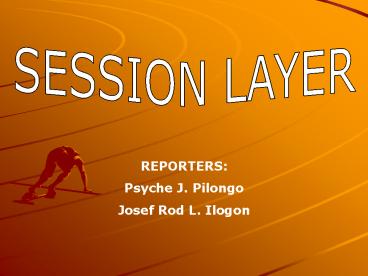SESSION LAYER - PowerPoint PPT Presentation
1 / 19
Title:
SESSION LAYER
Description:
Allow the user to delimit data into logical units called activities. ... Activities might be used to delimit files of a multi-file transfer. ACTIVITIES ... – PowerPoint PPT presentation
Number of Views:438
Avg rating:3.0/5.0
Title: SESSION LAYER
1
SESSION LAYER
REPORTERS Psyche J. Pilongo Josef Rod L. Ilogon
2
Session Layers -Descriptions -Functions -Servi
ces
3
The session layer resides above the transport
layer and below the presentation layer.
It is the thinnest layer in the OSI model.
4
The Session layer tracks connections,
also called sessions. The session layer keep
track of multiple file downloads requested by a
particiular FTP application, or multiple telnet
connections from a single terminal client, or web
page retrievals from a web server.
5
- establishes, manages, and terminates
- sessions between applications.
- the points strong of this layer is a
relative safety
6
Session layer protocols may be supplied by -
the distributed applications - the network
operating system - middleware - specialized
software which handles differences
between computing platforms
7
ISO-SP OSI Session Layer Protocol (X.225, ISO
8327) The OSI Session Layer Protocol (ISO-SP)
provides the session management.
The Session Protocol Machine (SPM), an abstract
machine that carries out the procedures specified
in the session layer protocol, communicates with
the session service user (SS-user) through an
session-service-access-point (SSAP) by means of
the service primitives. These protocol
exchanges are effected using the services of the
transport layer.
8
(No Transcript)
9
The Session layer performs the following
functions Communication with the
Presentation layer above. Organize and
manage one or more connections per
application, between hosts. Communication
with the Transport layer below.
10
SESSION LAYER SERVICES
- DIALOGUE CONTROL
- SYNCHRONIZATION
- ACTIVITY MANAGEMENT
- EXCEPTION REPORTING
- DATA TRANSFER
11
DIALOGUE CONTROL
Just as human discussions require coordination of
who should speak when many communications
applications require coordination of which
application entity has the right to send at a
particular time. At connection establishment
time the type of dialogue can be negotiated to be
either Half-duplex can be down graded to
duplex during the negotiation process. If a
Half-duplex dialogue is selected the right to
send is controlled by the Data token.
- Duplex
- Half Duplex
- Data token is attribute of a session connection.
- Tokens control access to some services.
- Any token can be
- -Not available
- -Assigned to one of the session
- users
12
- SYNCHRONIZATION
- Allows users to. . . .
- Placement of synchronization Markers in the
- data stream.
- 2. Notification of the need to resynchronize
- and to which marker.
- 3. Purging of unwanted data during
- resynchronization.
13
- Synchronization is achieved through the used of
sequence number - Major Synchronization
- must be confirmed
- inhibits further data transfers until
confirmation is complete - Minor Synchronization
- may optionally be confirmed
- does not inhibit data transfers
- - confirmation implies confirmation of all
previously - unconfirmed synchronization points.
14
- Resynchronization
- can return to (using Restart)
- last major synch. point
- any minor synch point following the last major
synch. point - - can give up on the current dialogue and start a
new one - (Abandon)
- can go to specified synch. point (using Set)
- once resynchronization has been initiated,
subsequent data is - abandoned until the resynch. is confirmed
- - the present of expedited data PDUs makes things
more - complex
15
Activity management Allow the user to delimit
data into logical units called activities. Each
activity is independent of activities that come
before and after it, and an activity can be
processed on its own. Activities might be used
to delimit files of a multi-file transfer.
16
- ACTIVITIES
- the largest subdivision of a session (may
correspond to a user login) - activities may be
- started
- ended
- interrupted
- resumed
- discarded
- starting a new activity resets the
synchronization numbering. - an activity may span several session connections
- when under activity-management, a connection
without an activity in - progress is limited to
- capability exchange
- activity begin
- token management
17
- Exception Reporting
- A general purpose mechanism for reporting
errors. - Allows users and provider to indicate that an
- exception has occurred
- Discards unwanted data until recovery occurs
18
Data transfer is provided in four forms
Normal data transfer is the ordinary data
delivery method. Expedited data has some
priority and is able to bypass some restrictions
that might impede the transfer of normal data.
Expedited data is restricted to small packets,
whereas normal data has no such restriction.
Typed and Capability data types are specific
to the Session Layer. They are used principally
to permit overrides of dialog control mechanisms
that may be in effect.
19
END OF REPORT































